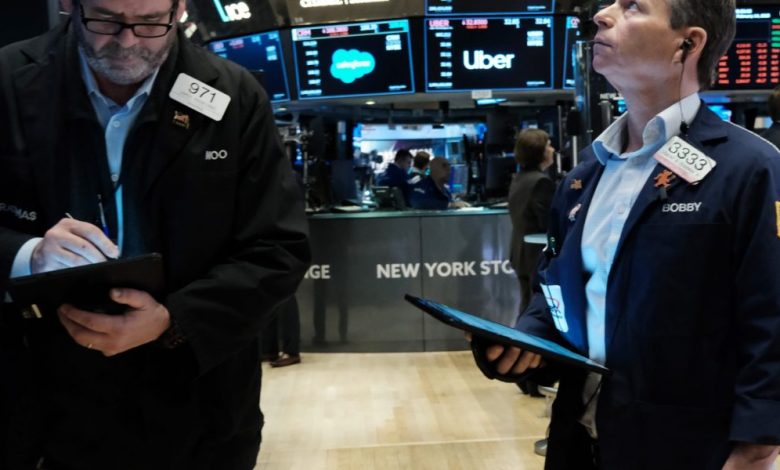Wall Street is losing hope of a soft landing for the economy. Get to know the “no landing”.

Renewed pressure on the Federal Reserve to intensify its inflation fight in the grip of a still-resilient economy is forcing Wall Street pros to reconsider the stock trading landscape.
After a worrying consumer prices report was released on Tuesday, bond investors have boosted expectations that interest rates will rise above 5% and stay there. The two-year Treasury yield rose sharply again, with bets on rate cuts later this year all but disappearing – a reversal of dovish bets placed just weeks ago.
The picture isn’t nearly as clear in stocks, where bulls and bears are battling over what matters more: rising interest rates or an economy that has grown fast enough over the past month to create half a million new jobs. Tuesday’s trading reflected both sides of the debate, with the S&P 500 rising, then falling and then recovering as traders weighed still-high consumer prices against recent economic and earnings data that showed little sign of a serious slowdown.
Barclays Plc strategists foresee an economic regime in which growth will continue while central banks are likely to remain in hawkish policy for longer, a scenario known as no-landing. The bank has upgraded both its growth and inflation forecasts for the US.
“Market expectations appear to have moved from a hard landing to a soft landing and now no landing – the regime of robust growth and higher for prolonged inflation – which is somewhat supportive for equities,” said Barclays strategist Emmanuel Cau. “Today’s CPI data maintains the status quo in this regard.”
A five-week rally to start the year faltered this month, but with the S&P 500 down less than 2%, it’s hard to say the market has given a decisive signal. For now, strategists who warmed up for equities in January are suggesting further gains will be harder to come by while at the same time less fearful of a major sell-off.
Morgan Stanley switched from an overweight to a neutral position in US Treasuries in anticipation of a tighter monetary policy stance and expects investors to reduce their short dollar positions as they shed the idea of an impending monetary policy turnaround.
“The market debate is likely to revolve around the interest rate sensitivity of the economy and whether the neutral rate should be higher than previously thought,” the bank’s strategists said.
While not the norm, periods when relatively high interest rates have been matched by robust earnings growth are not unprecedented in the US. Earnings in the S&P 500 rose in the second half of the 1990s, just as the Fed was ramming interest rates higher. And while the central bank’s efforts to normalize monetary policy late in the last decade eventually destroyed stocks in the last quarter of 2018, corporate earnings actually soared throughout Donald Trump’s administration.
Fed officials took the latest inflation data as another signal that interest rates must return to such levels to ensure inflation continues to fall. That view has plagued dip buyers for almost a year, prompting renewed warnings on Wall Street that the stock rally cannot continue.
“The Fed has won every single one of those battles over the last 18 months – every time the markets have tried to price out or discount the Fed’s rhetoric or forecasts, the markets have basically lost that battle, they’ve lost that game chicken,” said Brian Nick, chief investment strategist at Nuveen.
longer higher
Nonetheless, fears of a recession – although all but guaranteed at the start of the year – have receded. In the most recent fund manager survey by Bank of America, investors are far less pessimistic about the economy than they were just a few months ago. Just 24% of respondents expect a recession, down from 77% in November, and the number of investors expecting a rate cut over the next 12 months is at its highest since March 2020.
“The biggest tail risk [is] inflation is still “higher for longer,” according to the survey results.
Because the possibility of the US economy avoiding a recession also implies that the Fed will have a hard time starting to cut rates.
“China’s reopening, lower European gas prices and robust US job growth have reduced the likelihood of a near-term recession. However, this should also make core inflation more resilient and pave the way for more rate hikes,” Barclays’ macro team wrote in a report this week.
All of this is putting the brakes on an ongoing risk rally. Goldman Sachs strategists are neutral on equities over the next three months on improving macroeconomic conditions and reduced downside risks, but cautioned that markets’ risk appetite is “way ahead of the data”.
Christopher Harvey, head of equity strategy at Wells Fargo, sees a prime rate of 5% or less than what Fed swaps are currently allocating, but even that may not result in a sustained recovery. Still, he says the bear market days are behind us.
“We are seeing inflation stubbornly lower and the economy more resilient than expected with Fed funds closing at 5%,” Harvey said. “This is neither a great nor a terrible environment for stocks.”
Learn how to navigate and build trust in your organization with The Trust Factor, a weekly newsletter exploring what leaders need to succeed. Login here.



